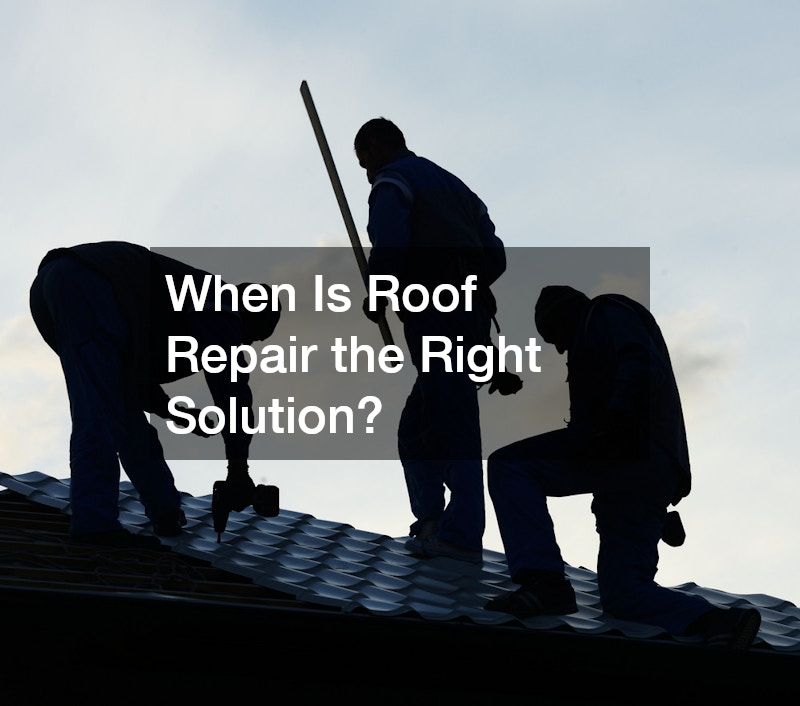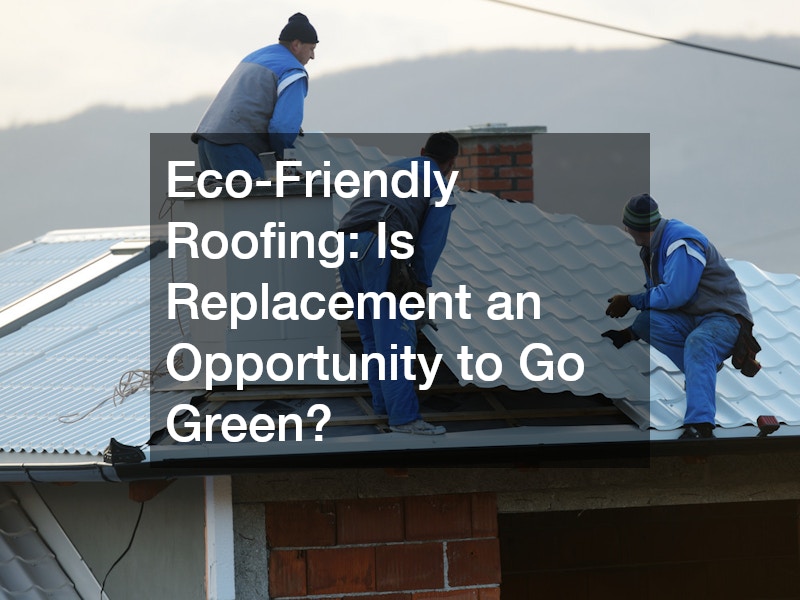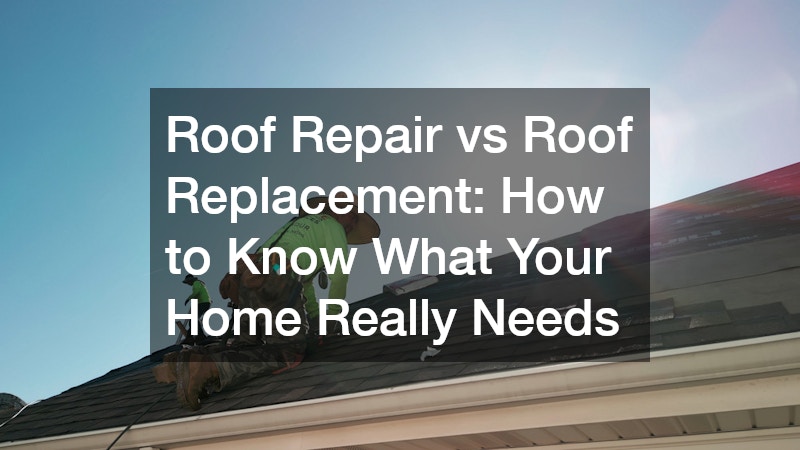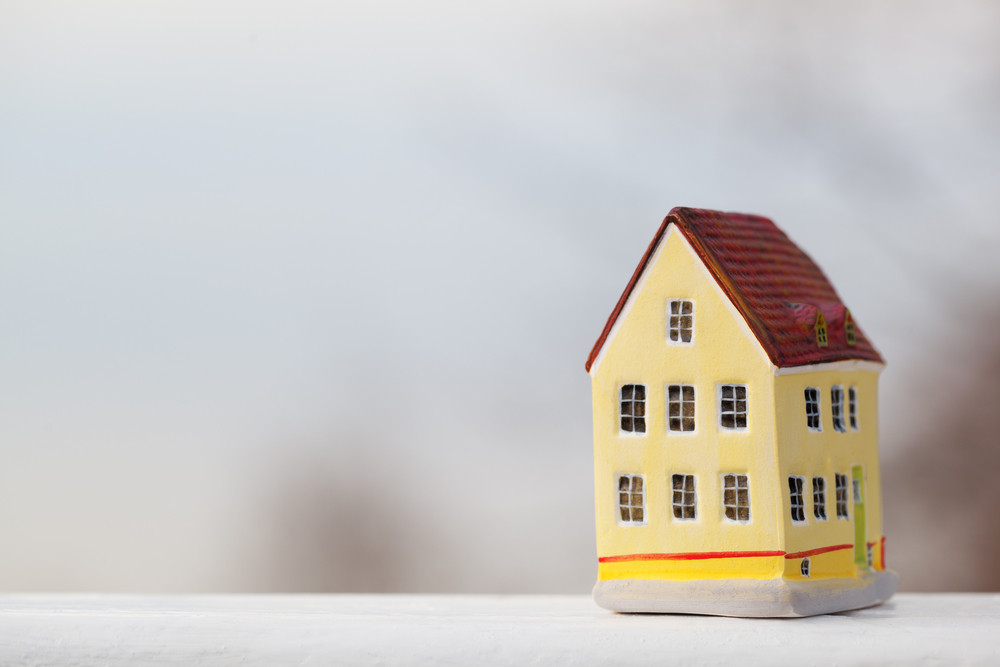Your roof protects everything and everyone underneath it. Over time, it inevitably faces wear and tear from storms, harsh sunlight, and the passage of years. But when it starts showing signs of trouble, many homeowners face the same question: Should I repair the damage or replace the entire roof?
This decision isn’t always straightforward. While repairs can be quicker and more affordable, they may not always be enough. On the other hand, replacement is a major investment, but it could save you more in the long run.
In this article, we’ll help you navigate this critical decision. You’ll learn how to assess the condition of your roof, compare repair and replacement costs, and make an informed choice that supports the safety, value, and longevity of your home.
Spotting the Warning Signs: Does Your Roof Need Help?
Before you choose between repair and replacement, it’s important to identify the signs that something might be wrong. Some roof problems are obvious, while others are subtle and require a closer look.
Common Indicators of Roofing Issues:
- Water stains on ceilings or walls: This often signals a leak.
- Missing or damaged shingles: Can expose the underlying structure to the elements.
- Sagging areas on the roof: Indicate structural damage beneath the surface.
- Daylight in the attic: Gaps or holes in the roof allow sunlight and moisture through.
- Excess granules in gutters: Asphalt shingles shedding granules is a sign of aging.
- Unexplained spikes in energy bills: May point to poor insulation or ventilation caused by roof deterioration.
These signs shouldn’t be ignored. Minor issues can quickly escalate into bigger, more expensive problems if left unchecked.
When Is Roof Repair the Right Solution?

Roof repairs can be a cost-effective way to fix problems—if they’re caught early and are relatively isolated. For many homeowners, repair is the preferred first option, especially if the roof is still within its expected lifespan.
Choose Repair If:
- Your roof is under 10–15 years old.
- The damage is limited to a small area, such as missing shingles or a small leak.
- There is no underlying structural damage.
- You’re not planning to stay in the home long-term.
- The issue was caused by a specific event, like a fallen tree limb or a small storm.
Advantages of Roof Repair:
- Lower cost upfront
- Less time-consuming—repairs can often be completed in a day
- Minimal disruption to your daily life
- Environmental benefits by reducing waste
Potential Drawbacks:
- Aesthetic mismatch between new and old materials
- Recurring costs if repairs become frequent
- Shorter lifespan than a full replacement
- May mask deeper issues not addressed during a quick fix
When Is Roof Replacement the Better Choice?
There comes a point when patching up the same roof repeatedly becomes inefficient and more costly than starting fresh. A full roof replacement eliminates existing issues and helps prevent future problems.
Consider Replacement If:
- The roof is 20 years old or older, or near the end of its warranty.
- Damage is widespread, not just in one area.
- Leaks keep recurring, despite previous repairs.
- The roof shows signs of structural compromise.
- You’re planning to stay in the home for the next 10–20 years.
- You want to upgrade roofing materials for aesthetics or energy efficiency.
Benefits of Replacing Your Roof:
- Adds property value and improves curb appeal
- Improves energy efficiency with modern materials
- Eliminates recurring repair costs
- Longer warranties, often 20–50 years
- Peace of mind knowing your roof is fully protected
Disadvantages:
- High upfront investment
- Longer project duration (usually several days)
- Requires permits and may involve inspections
- Potential need for temporary relocation during extensive work (in rare cases)
Roof Repair vs Roof Replacement: Key Considerations
Let’s break down the major decision points when comparing the two options.
1. Age of the Roof
The older your roof, the more likely it is that a replacement will be the smarter investment. Different materials have different lifespans:
| Roofing Material | Average Lifespan |
| Asphalt Shingles | 15–30 years |
| Metal Roofing | 40–70 years |
| Clay or Slate Tiles | 50–100 years |
| Wood Shakes | 20–40 years |
2. Extent of the Damage
- Small, isolated damage (e.g., one leak or a few broken shingles): consider repair.
- Multiple problem areas or underlying structural concerns: go with replacement.
3. Cost Comparison
- Repairs typically cost $300–$1,500, depending on the issue.
- Replacements range from $5,000–$15,000+, depending on size and materials.
It’s tempting to fix a problem for a few hundred dollars, but that can quickly turn into thousands in repeat repairs. Always weigh long-term value against short-term savings.
4. Energy Efficiency and Modern Upgrades
New roofing systems offer better insulation and reflective technology, which can lower your energy bills. If your existing roof lacks these features, replacement could lead to long-term savings.
5. Future Plans
- Selling within 5 years? A repaired roof may suffice.
- Staying long-term? A new roof offers better durability and peace of mind.
How Location and Weather Impact Your Choice
Your local climate plays a major role in how your roof wears down—and how you should respond.
In Humid or Rainy Climates:
- Moisture accelerates rot and mold.
- Frequent rain means leaks can cause widespread damage quickly.
- Moss and algae may reduce roof lifespan.
In Snowy Regions:
- Heavy snow adds weight and stress to older roofs.
- Freeze-thaw cycles increase cracking and lifting.
- Ice dams can force water under shingles.
In Hot and Sunny Areas:
- UV rays degrade roofing materials over time.
- Thermal expansion and contraction cause shingles to curl or crack.
- Reflective materials may be needed to combat heat buildup.
Your roofing professional can recommend materials suited to your local weather patterns if you’re considering replacement.
Are Roof Repairs Worth It Long-Term?
Sometimes a simple repair is all your roof needs—but not always. Let’s look at how long repairs typically last and when they stop making financial sense.
Typical Lifespans of Repairs:
- Shingle patching: 5–10 years
- Flashing repair: 10–15 years
- Leak repair: 3–7 years (depending on conditions)
If you find yourself calling a roofer every year or two, replacement may be the smarter, more cost-effective solution.
DIY Roofing: Is It Ever a Good Idea?
Roof repairs may look easy on YouTube, but working at height with heavy tools is dangerous and often requires experience. In fact, DIY mistakes can void manufacturer warranties or cause more damage.
DIY Might Be Acceptable For:
- Cleaning gutters
- Replacing a few blown-off shingles
- Clearing debris after a storm
Professional Help Is Best For:
- Leak detection
- Flashing or structural issues
- Mold or rot under roofing
- Full replacements or major repairs
Choosing the Right Roofing Contractor
Whether you need a repair or replacement, your roofing contractor plays a crucial role in the quality and longevity of the work.
What to Look For:
- Proper license and insurance
- Experience with your roof type
- Transparent estimates and timelines
- A track record of positive reviews
- Warranties on both materials and labor
Avoid contractors who pressure you into decisions or offer extremely low prices. Get at least two to three quotes before making your decision.
How Regular Maintenance Delays the Need for Roof Replacement
Preventive maintenance is one of the best ways to extend the life of your roof and delay costly replacements. Just like any part of your home, your roof needs attention even when it seems to be working fine. Catching minor problems early can save you thousands of dollars in major repairs or even premature roof failure.
Key Maintenance Tips:
- Clean gutters regularly to prevent water backup and roof rot.
- Trim overhanging tree branches to avoid damage from falling limbs.
- Inspect your roof after storms to identify damage early.
- Remove debris (leaves, moss, algae) that can trap moisture and degrade shingles.
- Check flashing and sealants around chimneys, vents, and skylights for cracks or gaps.
- Schedule annual professional inspections, especially before and after winter or storm season.
A proactive approach to roof care keeps minor issues from escalating and ensures your roof performs at its best for as long as possible.
Eco-Friendly Roofing: Is Replacement an Opportunity to Go Green?

If you’re leaning toward a roof replacement, it may be the perfect time to consider eco-friendly roofing options. Sustainable roofing materials not only reduce environmental impact but can also save you money in the long term through improved insulation and energy efficiency.
Environmentally Friendly Roofing Options:
- Metal roofing: 100% recyclable, reflects heat, and lasts 40–70 years.
- Cool roofs: Use reflective coatings to reduce heat absorption and lower cooling costs.
- Recycled shingles: Made from rubber, plastic, or wood fiber.
- Solar shingles: Combine roofing and solar energy generation in one.
- Green (vegetative) roofs: Add insulation and reduce stormwater runoff, though best for flat-roof systems.
Benefits of Going Green:
- Reduced carbon footprint
- Lower utility bills
- Potential eligibility for tax credits or rebates
- Increased property value and modern curb appeal
Upgrading your roof is a rare opportunity—so if sustainability matters to you, it’s worth exploring greener alternatives during your planning process.
Frequently Asked Questions
Can I replace only part of my roof?
Partial replacements are possible but not always recommended. They can lead to aesthetic mismatches and may not be covered under some warranties.
How long does a full roof replacement take?
Typically 1–5 days, depending on weather, roof size, and material.
Does homeowners insurance cover roof work?
Only if the damage was caused by a covered event, like a storm or fire. Wear and tear or neglect are usually not covered.
Final Thoughts: Making a Smart Roofing Decision
Choosing between roof repair and roof replacement is a big decision—but one you can make confidently with the right information.
Here’s a quick guide:
Choose Roof Repair If:
- The damage is minor or isolated
- The roof is relatively new
- You’re looking for a short-term solution
- Your budget is limited right now
Choose Roof Replacement If:
- Your roof is 20+ years old
- Damage is widespread or recurring
- You want to boost home value
- You’re planning to stay in the home long-term
Either way, always get a professional roof inspection before making your final decision. A qualified contractor can spot issues you might miss and help you understand the best path forward.



